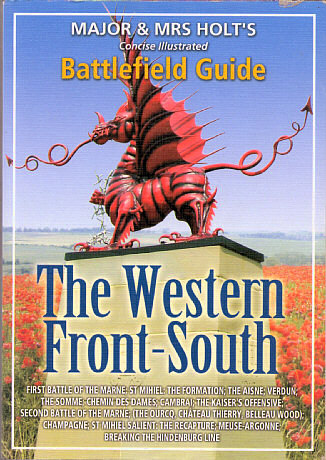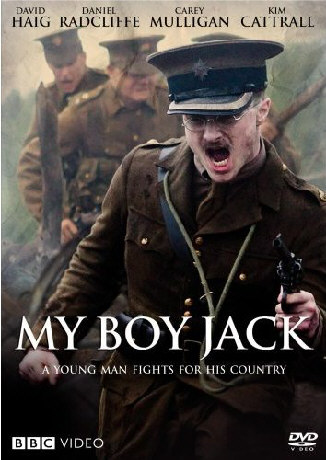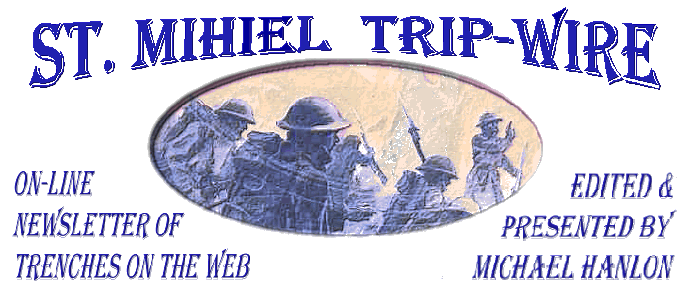
TRENCH REPORT: January is a good time to lay out your plans for the upcoming year. I would like to urge you to do something active about your interest in the events of 1914-1918. If you can, attend one of the events offered by the World War I history organizations we have listed below. I guarantee you will discover some new things and meet a lot of folks who share your interests. Perhaps there is a museum nearby that has a selection of items--weapons, equipment, aircraft, personal memorabilia from WWI. Make a visit if you can. You will see below that the WFA-USA has begun compiling information on U.S. museums from the war. Is there a war memorial in your town? Send us a photo if you can. Do you like films? Checkout Andy Melomet's regular reviews of classics, documentaries and new videos that touch on the war. All of us enjoy reading, but I think you'll find a variety of experiences will increase your enthusiasm for learning. MH
This Month's Internet Feature
A Half-Dozen WWI Generals Who Were
NOT Donkeys
Alexei Brusilov, Russia
Hunter Liggett, USA
Horace Smith-Dorrien, GB
John Monash, Australia
Henri Gouraud, France
Mustafa Kemal, Turkey
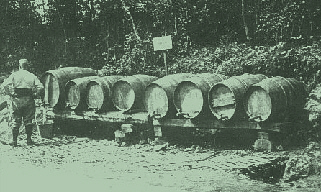
A Poilu Draws the Wine Ration
New at Our Own & Our Friends' Great War Websites
Click on Title or Icon to Access
|
At Tom Morgan's HELLFIRE CORNER
At Great War Society Sites
At the WFA-USA
|
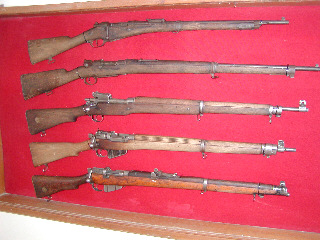
Current WWI Rifle Display
Iraqi Military Academy at Ar Rustamiyah

The small caliber and limited number of [artillery] guns involved in most of the lesser wars at the end of the 1800s meant that no one was prepared for the devastating effects of massed, large-caliber artillery fire on the battlefield [of 1914]. To complicate matters further , in the nine years between the Russo-Japanese War and the start of World War I, a final technological change occurred in the explosive charges contained in artillery rounds. The experiments of Alfred Nobel and others gave all armies high-explosive rounds that were much more destructive than the artillery shells of the nineteenth century.Capt. Jonathan M. House, U.S. Army
2008 Walking Tour of American and German Battlefields
Tour Guides Randy Gaulke and Markus Klauer (from Germany) are offering a five-day, small-group (12 max.) Walking-Oriented Tour in August 2008. The tour will spend three days in the Meuse-Argonne sector, one day in the St. Mihiel Salient and one day touring the Verdun battlefields. The tour will look at both the American and the German sides of the conflict; and it will involve significant walks--making this format somewhat unusual. (email)
|
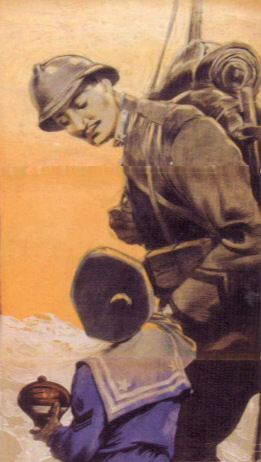
Italian War Poster (detail)
GREAT WAR 2008 EVENT CALENDAR
|
|
|
WFA-Pacific Coast Branch General Mtg &Seminar
Canadian Scottish Armory, Victoria, BC
March 7-9, 2008 (information)
|
WFA-USA National Seminar
Carlisle Barracks, PA
America's Great War -
America's Great Warriors
September 12-14 2008 (information)
|
Western Front Association
U.S. Branch Chapter Meetings
Check for Your Region
Regularly Updated (details)
|
Great War Society Monthly Chapter Meetings
Berkeley, San Francisco and Palo Alto, CA
Regularly Updated (details)
|
Send additions/corrections:
Email Response
|

Memorable Event
|
Woodrow Wilson Presents His Fourteen Points
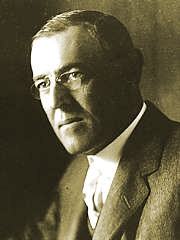
The President's Peace Plan
January 8, 1918
Click on Image for Complete Speech
|
|
Reader Brendan Timins reports from the Classical Music Front: The World Requiem by John Foulds was played by the BBC Orchestra a few weeks ago for the first time since the 1920s. (link)
Doughboy chronicler Steve Harris's history of the fabled Fighting 69th and its beloved chaplain, Duffy's War, is now available in paperback. (Amazon.com)
Remember the story of Louis XVI and Marie Antonette stopping in mid-flight from Paris for a 'fix' of Brie cheese and wine and being spotted by agents of the revolution and ultimately doomed as a result? Well, that occurred at the village of Villeroy, which happens to be the very place where the First Battle of the Marne opened in September 1914. Our friends Olivier and Phillipe at the Villeroy Musée 14/18 have organized a major reenactment of the battle scheduled for 7 September 2008. My parent travel company has asked me to see if there is interest in a one-week trip to France which would feature the reenactment, visits to other WWI battlefields and, possibly, some Brie and wine. Please send me an email if this might be something you would like to join. (email)

The image which danced before Wilhelm's eyes as the most wonderful prospect for the future was to see himself at the head of a great, a very great, German fleet starting out on a peaceful visit to England. At the heights of Portsmouth the English sovereign at the head of his high seas fleet would await the German Kaiser. The two fleets would file past one another; each of the sovereigns standing on the bridge of their respective flag ships wearing the naval uniform and decorations of the other. Then following the obligatory embraces and kisses, a gala dinner with splendid speeches would be held
at Cowes. Bernhard Furst von Bülow, Memoirs
|
La Madeleine, Paris, July 14, 1919
|
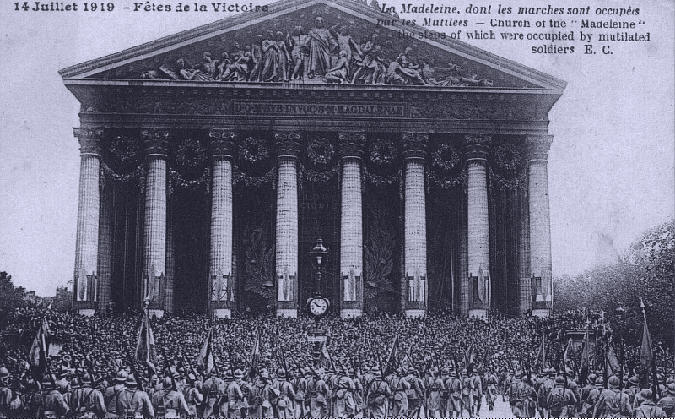
|
|
|
Page Two
|
|
|
|
J. Russell Coffey, the oldest known surviving U.S. veteran of World War I, died on December 20th. The retired teacher, one of only three remaining U.S. veterans from the "war to end all wars," was 109. Coffey never saw combat because he was still in basic training when the war ended.
The two remaining U.S. veterans are Frank Buckles, 106, of Charles Town, West Virginia, and Harry Richard Landis, 108, of Sun City Center, Florida, according to the Veterans Affairs Department. In addition, John Babcock, 107, of Spokane, Washington, served in the Canadian army and is the last known Canadian veteran of the war.
|

|
Ditch Clearance at Fort Douaumont
By Christina Holstein
|
Like all the forts in the Verdun region, Fort Douaumont was surrounded by a dry ditch. This was defended by three strong concrete bunkers that were embedded in the outer corners and so positioned as to sweep the floor of the ditch with fire if any enemy managed to penetrate that far. The outer wall, or counterscarp, was vertical and faced with dressed stone, while the inner wall, or scarp, consisted of a steep earth rampart that was protected at the base by a stout iron railing. A similar railing, two and a half metres high, was set into the top of the counterscarp to prevent access to the ditch below.
In recent years, Fort Douaumont's ditch had become so overgrown that it was difficult to get any idea of its profile and strength, but current clearance work is revealing many hidden features. It is not yet clear whether the entire ditch will be cleared or whether, as in previous years, the work will stop at the double bunker in the north side of the fort. The following series of recent views give some idea of the strength of the ditch, always remembering that in 1916 it was about ten feet lower than it is today due to natural filling and sliding walls.
 |
A. View along the western ditch toward the gun bunker |
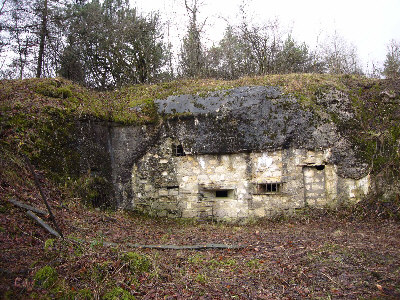 |
B. The gun bunker |
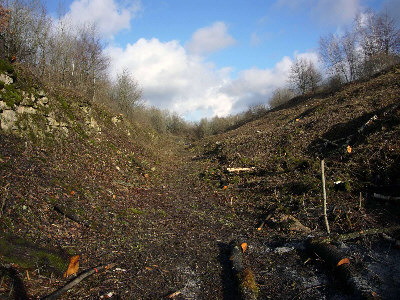 |
C. View toward the double bunker at the northern apex of the fort |
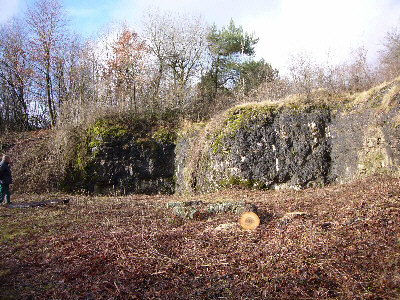 |
D. The double bunker |
 |
E. Still buried in undergrowth, a section of the railing that protected the base of the scarp |
|

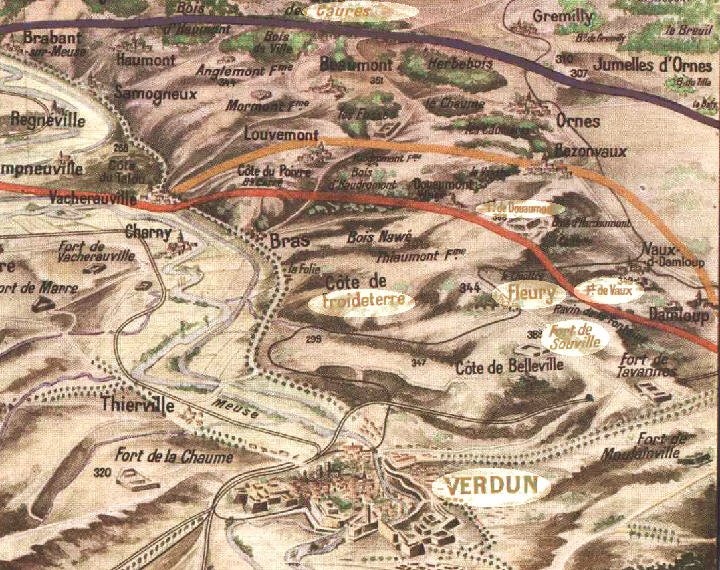
Key Sites of the Battle of Verdun [East Bank]:
Verdun City; Forts Douaumont, Vaux, Souville; Froideterre; Fleury Village; Bois des Caures
Click Here to Visit War in a Different Light
|
| Eyewitness: Sarajevo, June 28, 1914
|
Count Franz von Harrach, serving as a bodyguard for the Archduke, rode on the running board of the royal car. His account begins immediately after Princip fires his two shots:
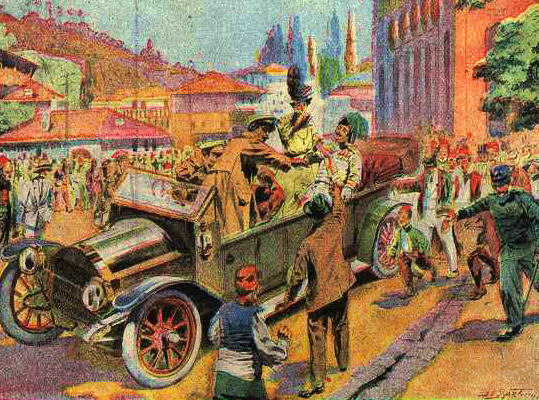
Somewhat Inaccurate Depiction of the Assassination
As the car quickly reversed, a thin stream of blood spurted from His Highness's mouth onto my right check. As I was pulling out my handkerchief to wipe the blood away from his mouth, the Duchess cried out to him, 'In Heaven's name, what has happened to you?' At that she slid off the seat and lay on the floor of the car, with her face between his knees.
I had no idea that she too was hit and thought she had simply fainted with fright. Then I heard His Imperial Highness say, 'Sopherl, Sopherl, don't die. Stay alive for the children!'
At that, I seized the Archduke by the collar of his uniform, to stop his head dropping forward and asked him if he was in great pain. He answered me quite distinctly, 'It's nothing!' His face began to twist somewhat but he went on repeating, six or seven times, ever more faintly as he gradually lost consciousness, 'It's nothing!' Then, after a short pause, there was a violent choking sound caused by the bleeding. It was stopped as we reached the Konak.
|
Source:
"Assassination of an Archduke,"
EyeWitness to History, www.eyewitnesstohistory.com (1998).
|
|

|
1918 on The Western Front
By Tony Noyes
January
What Is Coming?
|
January 1st:
The darkest hour before dawn.
STAND TO!
Along the front of 450 miles, on both sides of the line, men left the fug of their crowded dugouts, stood shivering in the darkness and waited, weapons ready, for an attack across the foul, frozen, wastes of no-mans-land by those soldiers opposite.
In turn, those opposite waited for a similar attack.
They had all done this every morning since the early days of the war in 1914 when the fighting and the front lines changed from a war of movement into static warfare.
There were not many of the old originals left; those who remained in the trenches were often aging veterans in their twenties.
A few had been promoted to senior positions that removed them from the actual front lines. A large number had been discharged from the army as being no further use due to debilitating wounds, (which often meant that they were unemployable in civilian life and condemned to a life of penury).
Some had been patched up and 'returned to service'.
The rest were dead.
As 1918 dawned, the German military faced a Good News / Bad News scenario. The Good: Russia had been knocked out of the war, Italy was down and almost out after Caporetto, and in the west, after 1917's failed Nivelle Offensive and ensuing disorder, and the grinding down of Passchendaele, the British and French armies were no threat to retake the occupied areas of northern France and Flanders.
The Bad: the people of Germany were beginning to suffer mightily from the naval blockade and the costs of waging total war. Unrestricted submarine warfare had not brought the expected decisive results, and, ominously, American troops were about to start arriving in huge and accelerating numbers.
The Hindenburg-Ludendorff solution: force the British and French to settle on terms advantageous to Germany -- before the Americans arrived in strength. From March through July, the German Army, using the million additional men now no longer needed in the east, mounted a major offensive each month. In 2008, Tony Noyes will be telling us about the planning and execution of each of these operations, known by many names, but which we will call the "Ludendorff Offensives". Then in midyear, just as the tide of battle turned in July 1918, Tony will describe, step-by-step, the series of Allied "Victory" offensives culminating in the November armistice.
|
|
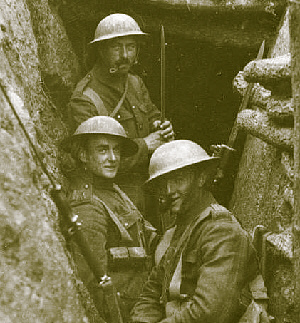
'Standing To', British Trench
Manpower in all the armies was a continuing problem with the need for men far outweighing the numbers still available. Women had taken over many of the men's jobs, often taking positions that had always been a male preserve. The men called for service were getting younger, and their army training was shorter and sometimes perfunctory.
The man in the trench, wrapped up in any garments that kept out the penetrating cold stared out into the dark, stamping his feet to get some warmth into them. As the dim winter sun began to light the skyline, he saw the same sights as yesterday and many days before. He saw the old skeleton still dressed in its mouldering uniform from many days past. He heard the rattle of the tin cans hanging on the wire to give warning of incoming fighting patrols, he heard and saw the gigantic rats exploring in their constant search for food. He didn't notice the appalling smell of his surroundings which was, by now, a way of life.
He became aware of his compatriots beside him, staring into the lightening darkness, and doubtless thinking, as he was, of a brew-up and, with luck, breakfast. All the while, he hoped that the enemy would not see the smoke from the cooking and launch a salvo of mortar bombs into the trench to destroy his few minutes of peace before the business of the day began: the interminable job of maintenance on the maze of trenches and wire which, with acceptance of wounds and death, was his world. He could not envisage any other. Was there really a world of warmth, laughter and a woman's company existing somewhere else?
The year of 1918 did not start with any possibility of hope for an end to this purgatory.
|
|
|
Subscribe to Our New On-Line Magazine
|
|

|
|
|
Page Three
|
 |
Major & Mrs. Holt's Concise Illustrated Battlefield Guide:
The Western Front -- South
Reviewed by Editor Mike Hanlon
|
Last month I gave the readers a strong BUY! signal on the reissue of Sewell Tyng's classic battle study The Campaign of the Marne. Since then --I guess because most of you know I also lead annual tours of the Western Front battlefields --I've received inquiries about visiting the sites described in Tyng's work. This is a considerable challenge because the 1914 battle was fought along a front over 120 miles long, extending from north of Paris to St. Mihiel in the east. In the past I've recommended two guidebooks to readers, Before Endeavors Fade by Rose Coombs, which is strongest on the British and Commonwealth sites, and the American Battle Monuments Commission publication American Armies and Battlefields in Europe. Neither of these, though, are particularly good on the First Battle of the Marne, in which the BEF played a rather small (but important) role and the AEF played none.
However, the prolific Travel/Publishing team of Tonie and Valmai Holt have come out with the most helpful source yet in their publication of The Western Front -- South illustrated guide. Its scope covers the battlefields of the Somme, the Aisne/Marne sector, the Champagne, Verdun, and St. Mihiel plus the overlapping 1918 American battlefields. The authors identify the key sites in each area, provide photos of most of them, and, most valuable, offer easy-to-follow maps. All the regions are well described, but especially noteworthy are the details about the 1914 operations around the Marne. The deployment of the Army of Paris, the retreat and return to action of the BEF, and the opening attacks at the village of Villeroy are described and positioned in a clear way, as are the innumerable monuments such as those around Meaux, at Dormans on the River Marne, and Mondemont above the St. Gond Marshes where Foch won his first glory of the war. Nevertheless, the Holts' treatment of the battle is not quite as comprehensive and unified as Sewell Tyng's. Operations on the Meuse heights, for instance, are covered in the section on St. Mihiel, but most of the big engagements of the Marne are to be found in the volume. All things considered, The Western Front -- South is an excellent general guide and is the best I can recommend for the sites of the First Battle of the Marne, the most important battle of the Great War. (Order at Amazon.com)
|
|
World War I Headlines
in the
21st Century
|
|
 |
My Boy Jack
By Andrew Melomet
|
The Battle of Loos in September 1915 was one of the meaningless, supposedly strategic battles fought in 1915. With the disaster of the Dardanelles campaign and the Russian defeats in Galicia and Poland, it was determined that there should be a major combined Anglo-French offensive on the Western Front. The French would concentrate on the Champagne sector and the British on the area of Artois. The Allied powers had an advantage in the number of men; the Germans had the advantage of a strengthened defense with large numbers of machine guns and superior numbers of artillery, mortars, grenades and ammunition. The British used poison gas for the first time. Unfortunately the chlorine gas released drifted back to the British lines and caused casualties among their own troops. Starting on September 25th, the battle lasted with limited gains until October 14th. The slaughter among the British was so great that the Germans called the battle "Leichenfeld (Field of Corpses) of Loos." The British suffered 60,000 casualties in the Battle of Loos. After the battle Sir John French was sacked, and three months later in December 1915 Sir Douglas Haig became Commander in Chief.
With the outbreak of World War One, the male youth of Britain inflamed with patriotism, propaganda and the fear of civil ostracism hastened to enlist in the armed services of the Empire. My Boy Jack recounts how John Kipling, (known as Jack) Rudyard Kipling's son, tried to enlist but was rejected due to his poor eyesight. Extremely nearsighted, Jack couldn't read the top line of the eye chart without his spectacles until he was three feet away from the chart. However, his father determined that his son would serve and used his personal influence with an aged Lord Roberts, the commanding officer, to get Jack a commission in the famed Irish Guards. Jack overcomes his physical weakness to become a true leader of men. However, he dies in the Battle of Loos and Kipling finds he must confront his conflicted emotions between his love of family and his love and devotion to King and Country.
Directed by Brian Kirk with a screenplay by Daniel Haig, who also plays Rudyard Kipling, My Boy Jack also stars Kim Cattrall as Kipling's wife Caroline and Carey Mulligan as Elsie Kipling, Jack's sister. Jack is played by Daniel Radcliffe. This is an exceptionally powerful drama, superbly acted and extremely moving. The tension within the Kipling family caused by Jack's commission, his fate and their reactions has emotional overtones that are heightened by today's political events. My Boy Jackwas aired in the U.K. on November 11, 2007, Remembrance Day, and has been released on DVD in the U.K. The DVD includes deleted scenes and insightful interviews with Daniel Radcliffe, David Haig and Kim Cattrall. My Boy Jack will be aired on PBS in 2008 and released on DVD in the U.S. in April 2008.
It helps to know something about the early years of World War One when watching My Boy Jack. Rudyard Kipling seems to be applying a great deal of pressure on his son to join up. But Jack seems just as eager to enlist and experience the great adventure of war as his friends are. Historically this is accurate, but in Jack's case it is also portrayed as a chance to get out of the house and away from his father with whom he has a complex relationship as the sole son of a famously patriotic father. With nearly a century of hindsight it would appear that trying to get a military commission is the same as trying to get a death sentence, but this is an anachronistic view. Many in command expected to war to be short one. Back in 1914 no one could reasonably foresee the extremely high casualty rates of the months and years ahead.
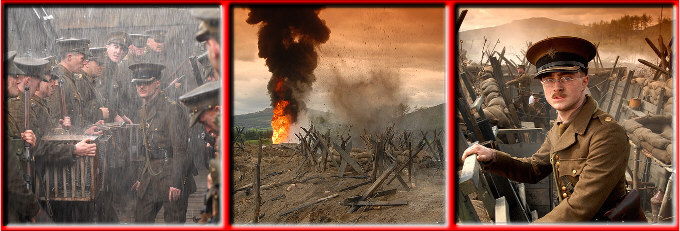
Stills From My Boy Jack
Jack was reported as missing, and the Kipling family searched hospital, Red Cross and prisoner of war records for years trying to find their son. In 1992 in a controversial decision the Commonwealth War Graves Commission announced that his body was identified. The Imperial War Museum has an exhibition on My Boy Jack through February 2008: (link)
It was Rudyard Kipling who composed the headstone for the unidentified fallen of World War One, "A Soldier of the Great War Known Unto God." The title My Boy Jackcomes from an elegy that Kipling wrote to honor his son. In 1923 his two- volume history on the Irish Guards was published. A sign of his changed feelings toward the war is the passage from "Epitaphs of the War":
If any question why we died
Tell them, because our fathers lied.
Andrew Melomet, Proprietor of Andy's Nickelodeon, will answer your Great War film or video inquiry. He is also soliciting your recommendations for the WWI Filmography he is compiling for our readers. Just click HERE.
Attention: Northern California Readers
On February 2nd, Andrew Melomet will be speaking at a luncheon meeting for the Society for Aviation History at the Cattleman's Restaurant in Newark, Calif. [east of the Dumbarton Bridge]. His topic will be Alexander de Seversky and "Victory Through Airpower". You can learn more about the meeting at the Society's website: (link) |
|
|
| The following are thanked for their contributions to this issue of the Trip-Wire: The many of you who sent the news about Russell Coffey, Diane Rooney, Tony Langley, Christina Holstein, Tony Noyes, Andy Melomet, Kimball Worcester. Lt. Col. Elton Johnson, who is regularly deployed to Iraq, sent the rifle image. Until next month, your editor, Mike Hanlon. |
SUBSCRIBE TO THE TRIP-WIRE
(Or send it to a friend)
(Or send us a comment on the TRIP-WIRE)
CLICK HERE TO CONTACT US VIA EMAIL |
For further information on the events of 1914-1918
and membership information visit the Directory Pages of:
|
| |























